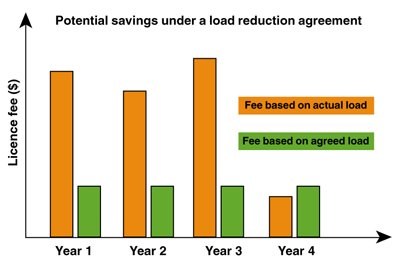Assessable loads
Assessable loads are the basis of pollutant load fees. Assessable pollutant loads must be calculated by licensees in accordance with the Load Calculation Protocol. The assessable load is the least of the actual, weighted or agreed loads for each assessable pollutant.
Actual load
The actual load is the annual mass of emissions of an assessable pollutant (in kilograms) and is measured as specified in the Load Calculation Protocol.
Weighted load
LBL recognises that certain methods of pollution load management can reduce environmental harm without reducing pollution loads. Licensees are encouraged to apply such methods through the provision of "load weighting" factors that reduce fees. In many cases, these methods achieve superior environmental protection at much lower cost than the sophisticated treatment technologies mandated by traditional regulation.
The three methods of harm reduction currently eligible for discounts are:
- Effluent reuse - The sustainable reuse of liquid wastes, to irrigate crops or in industrial processes (for example), can yield up to a 100% discount (i.e. zero fee) on assessable pollutants in that effluent, provided strict environmental management criteria are met. The effluent can be reused where it was generated or transferred for reuse beyond the licensed premises.
- Flow-optimised discharges - Pollutants discharged to rivers only during periods of high flow may be flushed faster, thereby reducing environmental impact. This can attract a 50% discount on discharges of assessable pollutant loads during peak flows in fast-flowing coastal rivers.
- Hunter River Salinity Trading Scheme - Licensees with pollutant load fees under this scheme receive a 75% discount on salt discharges, reflecting the fact that discharges are managed to coincide with periods of high river flows and are limited to keep the river fresh.
Agreed load
Licensees can enter into an agreement with the EPA to reduce the assessable load of selected assessable pollutants by a future date. The licensee then pays a reduced annual fee as if the improvements have already been achieved. Rebates (ie. discounts) are available for a maximum of three years under a load reduction agreement, with an additional year provided to demonstrate that the agreed load goal(s) have been achieved.
Load reduction agreements free funds that would have been paid as fees, for investment in improved environmental performance.

Fee savings under load reduction agreements can be significant. An additional year is provided (the fourth year in the diagram above) to demonstrate that the agreed load goal(s) have been achieved.
If licensees fail to meet agreed load targets, they must pay the EPA retrospective pollutant load fees on emissions in excess of the agreed target, plus 20% simple interest per annum calculated weekly, for the period of the agreement.

